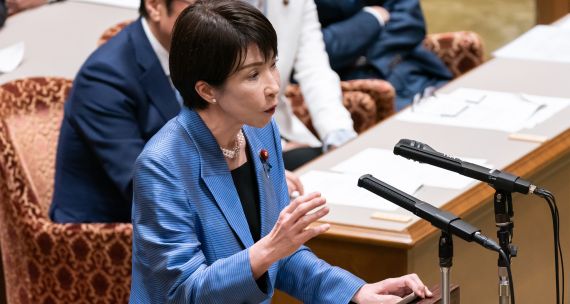In December 2024, LignoSat — the world’s first wooden satellite — was launched by the Japanese Aerospace Exploration Agency (JAXA) into the Earth’s orbit from the International Space Station (ISS). The satellite, constructed from magnolia wood and without screws using a traditional Japanese technique, was developed to make space more sustainable. Traditional satellites burn up upon re-entry when deorbited, creating significant environmental impact within the Earth’s atmosphere. This latest innovation illustrates Japan’s technical prowess in space.
Japan's space program, which has evolved incrementally over the past seven decades, reflects a balance of scientific ambition, commercial pragmatism, and geopolitical awareness. Unlike some global space actors whose programs are marked by rapid expansion or ambitious grand strategies, Japan’s trajectory has been steady, focused on achieving practical capabilities in satellite technology, launch vehicles, and space exploration missions.
The country’s Moon landing in January 2024 earned it a coveted spot in Asia’s space race. Of the five countries that have landed on the Moon, three are from Asia (China, India, and Japan, which followed the U.S. and the Soviet Union). Japan, however, is also the only Asian state that is a member of the International Space Station (ISS) and is a founding member of the U.S.-led Artemis Accords.
Recently, Japan has sought to expand its domestic space industry and strengthen its role in international space governance while navigating the complex geopolitics of the Indo-Pacific region. This includes recent cuts to NASA’s budget by the administration of U.S. President Donald Trump, which has created uncertainties in international space co-operation and prompted partner agencies to seek stronger alliances. In July, the Canadian Space Agency (CSA) reaffirmed its collaboration with JAXA, emphasizing that the increasingly complex global space environment necessitates robust international partnerships.
This report, the fourth in our series on Asia Pacific space players, provides an overview of Japan’s space program and industry, examining its legislative framework, commercial developments, international diplomacy, and bilateral engagement with Canada. It highlights Japan’s pragmatic and multifaceted approach to space, which balances scientific and commercial goals with emerging national security concerns.
Institutional and legislative foundations
Japan’s space activities are principally managed by JAXA, which was formed in 2003 to unify the country’s fragmented space efforts, combining research, development, launch operations, and international co-operation under a single organization.
The country’s trajectory in the space sector has since been informed by a succession of national strategies and legislative reforms, most notably the 2008 Basic Space Law and the subsequent Basic Space Plan. The law provided the legislative framework, while the plan functions as a government-wide policy roadmap that operationalizes the law’s principles and sets priorities for research, industry, security, and international co-operation. The first Basic Space Plan was adopted in 2009 and has been periodically revised to reflect shifting national and international contexts; the 2023 revision, for example, placed a stronger emphasis on defence applications and commercial partnerships. The Basic Space Law itself marked a paradigm shift in Japan's approach by explicitly recognizing space as a domain of national security as well as scientific exploration.
The most recent version of Japan’s Basic Space Plan, issued in 2023, outlines clear goals for the industry’s growth. It aims to expand Japan’s domestic space industry to approximately C$74 billion (¥8 trillion) by the early 2030s, effectively doubling its value from 2020. To realize these ambitions, the government established the Space Strategy Fund, a 10-year investment program that injects significant capital into space-related research, development, and commercialization. The fund prioritizes technologies that improve launch reliability, satellite innovation, space situational awareness, and security capabilities.
Japan’s legislative and policy frameworks are increasingly attuned to the dual-use nature of space technologies. Amendments to national defence and space activity laws now emphasize the integration of space capabilities within the broader security architecture, including collaboration with the Japan Self-Defense Forces (JSDF).
Japan’s space governance approach carefully balances its pacifist constitution with the need for security resilience in space, or the ability to mitigate and recover from disruptions. Tokyo’s policies emphasize responsible behaviour, transparency, and adherence to international norms, while ensuring national capabilities are prepared for emerging space security challenges. On July 28, Japan’s defence ministry released the country’s first guidelines on space defence, a turning point in Japan’s strategic posture.
The guidelines pledged to protect satellites used by the JSDF, safeguard commercial actors’ access to space, and strengthen public-private partnerships in building resilient architectures, reflecting a broader global trend. The guidelines also expressed concern about Russia and China’s activities, particularly the development of “killer satellites,” in-orbit rendezvous and proximity operations, and direct-ascent anti-satellite weapons — capabilities Tokyo views as threats to its space assets. China strongly condemned the guidelines, accusing Japan and its allies of using “defence” rhetoric as a pretext for militarization and warning that they could undermine outer space security and fuel regional militarism.
Meanwhile, Japan continues to deepen space co-operation with the U.S., engaging in initiatives around space situational awareness, proliferated satellite constellations for missile warning, and broader tactical collaboration within the U.S.–Japan alliance to counter China’s rising space capabilities. In essence, Japan now finds itself taking a more assertive space-defence posture and intensifying its strategic alignment with the U.S.— moves Beijing sees as destabilizing.
Commercial space development and government support
Globally, the space industry began as a primarily state domain. In recent years, however, the number of private actors has proliferated, including in Japan. Japan’s commercial space sector has gained momentum through a hybrid model of public-private partnership. Encouraged by a government that has assumed a role similar to that of a venture capital incubator, startups have become central to Japan’s vision for a more dynamic space economy. The Ministry of Economy, Trade and Industry, together with JAXA, has channelled public funds into ventures with high potential for commercialization and strategic value.
Axelspace, a Tokyo-based Earth observation satellite company, is a prominent example of this new wave of space firms. In mid-2025, it became the fifth Japanese space startup in two years to pursue an initial public offering. Having already launched five satellites and with plans to expand its constellation, Axelspace exemplifies the growing commercial viability of Japan’s space sector. Similarly, Astroscale, which specializes in orbital debris removal and satellite servicing, has emerged as a global leader in space sustainability, with contracts with major aerospace firms such as Airbus.
Japan’s launch vehicle program also illustrates this transition. The H-IIA rocket, first launched in 2001, was Japan’s workhorse for over two decades, completing approximately 50 successful missions with a success rate of about 98 per cent. It deployed communication satellites, scientific payloads, and resupply missions to the ISS. Its successor, the H-3 rocket, represents a new generation of launch vehicles designed for cost efficiency, increased payload capacity, and greater launch frequency. The H-3, built by JAXA and Mitsubishi Heavy Industries, reached orbit in late 2024 and is projected to conduct around 10 launches per year by the early 2030s, supporting both government and commercial satellite deployments. This vehicle is key to Japan’s efforts to establish more competitive and flexible access to space, addressing concerns about launch reliability and costs that have limited broader industry growth. Complementing these government-led efforts are smaller launch vehicles such as the Epsilon rocket, developed to service the expanding microsatellite market driven by the private sector. Epsilon’s solid-propellant design offers a cost-effective option for deploying smaller payloads and complements the capabilities of the H-3.
Japan's push to foster a commercial launch sector is also evident in the development of Spaceport Kii, the country’s first commercial spaceport. The facility is operated by Space One, which attempted Japan’s first private orbital rocket launch in March 2024. Although the launch failed shortly after liftoff, the mission signalled Japan's readiness to move beyond state-dominated launch capabilities. Interest from foreign firms, such as Taiwan's TiSpace, which also attempted, albeit unsuccessfully, to launch a rocket from Hokkaido Spaceport in northern Japan, underscores Japan’s growing ambition to become a regional hub for commercial space activity.
Despite Japan's many strengths in the space sector, several structural challenges persist. Most commercial startups in the space sector are not yet profitable, and capital markets are increasingly scrutinizing their long-term viability. While government funding offers a safety net, sustained growth will require more private investment and more clearly-defined commercial pathways. The failure of Space One’s inaugural launch also underscored the risks involved in moving from policy to execution. These domestic challenges intersect with Japan’s broader strategic calculations, as its ability to sustain a competitive space sector is closely tied to international partnerships and the geopolitical environment in which it operates.
Geopolitical strategy and international alignment
Japan’s advancements in space are unfolding against a backdrop of increasingly complex geopolitical dynamics in the Indo-Pacific. At the heart of Japan’s space diplomacy is its strategic partnership with the U.S. In 2023, the two countries amended Article V of their Treaty of Mutual Cooperation and Security, extending its provisions to space. They also collaborate on a broad range of initiatives, including the expansion of Japan’s Quasi-Zenith Satellite System (QZSS), a regional navigation system designed to complement the U.S.’s GPS network and enhance Japan’s autonomous positioning capabilities.
Co-operation further extends to space situational awareness, intelligence sharing, and joint research through multilateral frameworks such as the U.S.-led Artemis Accords. The Accords are non-binding and reinforce the provisions in the 1967 Outer Space Treaty based on the U.S.’s interpretations of resource extraction permitted under the treaty. Fifty-six states have signed on to the Accords, including Canada, India and South Korea.
Meanwhile, Japan continues to deepen security-oriented space co-operation with the U.S., engaging in initiatives around space situational awareness, proliferated satellite constellations for missile warning, and broader tactical collaboration within the alliance to counter China’s rising space capabilities. In essence, Japan now finds itself adopting a more assertive space-defence posture and intensifying its strategic alignment with the U.S. Beijing, however, sees these moves as destabilizing.
Recognizing the dual-use nature of space technologies, Japan has further integrated space into its broader defence strategy, emphasizing resilience and interoperability with allies. The QZSS, in particular, reflects Japan’s pursuit of independent yet allied-compatible capabilities, forming a key element of its national security posture. Beyond navigation, Japan is investing in space situational awareness systems, satellite-based communications, and early warning capabilities, all designed to reduce vulnerabilities in the event of conflict. These initiatives align with the country’s broader policy shift toward a more proactive security role and demonstrate how space has become a central domain in both deterrence and alliance co-operation. At the same time, Japan has sought to balance its U.S. partnership with a diversified diplomatic approach, recognizing that resilient space capabilities also depend on broad-based international collaboration.
Beyond its alliance with the U.S., Japan maintains active space diplomacy with a growing network of partners. It sustains strong bilateral relationships with the European Union and Canada. In July 2024, the CSA reaffirmed its commitment to working with JAXA on shared priorities such as satellite data sharing, regulatory harmonization, and space sustainability.
A key example of Japan’s expanding partnerships is its deepening space co-operation with India. The two countries have cultivated an increasingly fruitful partnership through both high-level policy dialogue and commercial ventures. In April 2025, the Third Japan-India Space Dialogue brought together officials from JAXA, the Indian Space Research Organisation, and various ministries to discuss areas of mutual interest, including satellite navigation, space situational awareness, global norms, commercial collaboration, and deeper bilateral co-ordination under the Quadrilateral Security Dialogue (Quad) framework.
On the private sector side, Japan’s Infostellar and India’s Dhruva Space inked a ground-station integration agreement, linking Dhruva’s Hyderabad antenna to Infostellar’s StellarStation network to enhance satellite communication interoperability across the Asia Pacific region.
On the commercial innovation front, Tokyo-based Orbital Lasers and Indian robotics firm InspeCity agreed to jointly study laser-equipped satellites capable of neutralizing space debris by vaporizing parts of a target’s surface to slow its rotation, a technology they aim to test in orbit by 2027. Meanwhile, Japan’s Astroscale and Indian space startups Digantara and Bellatrix Aerospace have formed a consortium to offer on-orbit debris removal and servicing services for Indian clients, marking Astroscale’s first Asia Pacific venture beyond Japan. Finally, both nations are moving forward on lunar exploration, with the joint LUPEX (Chandrayaan-5) mission targeting a 2028-29 launch to explore the Moon's south polar region through a combination of Japan’s H3 vehicle and India’s lander-rover architecture. Together, these efforts illustrate a multi-faceted and fast-evolving Japan–India space relationship that bridges government policy, commercial innovation, and long-term scientific exploration.
Japan is also a proactive participant in international efforts to shape the rules and norms governing space. It contributes meaningfully to initiatives such as the Artemis Accords, which promote responsible behaviour in lunar exploration and resource utilization, and engages in multilateral security dialogues such as the Quad, which increasingly includes space co-operation as a key area of focus. Quad members include Australia, India, Japan, and the U.S. Japan also plays a leading role in international forums like the United Nations Committee on the Peaceful Uses of Outer Space (COPUOS).
Building on this role, Japan is working to lead global discussions on the creation of international rules for disposing of space debris. Its Cabinet Office has convened an expert panel to draft proposals aimed at reducing orbital debris and plans to present these ideas in time for the 2026 COPUOS meeting. Orbital debris, particularly those larger than 1 cm in size, can cause substantial damage to satellites. According to the European Space Agency, as of 2024, the number of such debris is estimated to be over 1.2 million. With more actors, state and non-state alike, expected to launch satellites and ‘megaconstellations’ (large groups of hundreds to thousands of individual satellites that work together), the need to manage and dispose of the existing debris is urgent. Given Japan’s technology and support of its commercial space actors in this area, Japan is well positioned to lead in the creation of rules and norms on space debris management and disposal.
Canada and Japan’s shared ambitions
As global space activity becomes more diffuse and competitive, Japan’s role as a reliable, innovation-driven, and diplomatically active participant is increasingly important. Japan and Canada, both technologically advanced middle powers, have found common ground in space governance and industry development.
The July 2025 meeting between the CSA and JAXA reaffirmed this productive partnership. Collaboration spans the ISS, the International Charter on Space and Major Disasters, and Earth observation data sharing. Both countries are working on complementary lunar exploration technologies to support a sustainable human presence while advancing next-generation capabilities for security and sustainability. During their visit to Tokyo, the Canadian delegation participated in the SPACETIDE conference, Japan’s premier private-sector-led space business forum, which brings together government, industry, investors, and international partners to shape commercial space development. The delegation used the platform to showcase industrial capabilities and engage with Japan’s space sector, laying the groundwork for future partnerships.
By combining Canada’s strengths in robotics, Earth observation, and deep-space science with Japan’s expertise in satellite innovation, debris mitigation, and launch capabilities, the two nations are positioned to tackle both commercial and policy challenges collaboratively. Their bilateral engagement illustrates how collaboration can amplify the capabilities that might otherwise be eclipsed by larger players.
• Edited by Erin Williams, Programs Director, and Vina Nadjibulla, Vice-President Research & Strategy, APF Canada.





